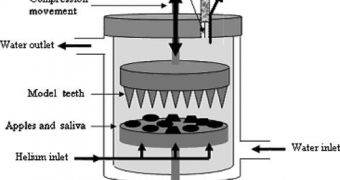The device, developed by a group of French researchers, can chew up hard foodstuffs and reproduce all processes that take place inside the human mouth while eating, including the release of saliva and flavor. It could probably be used in the future as a robotic food tester, to enhance the quality of food and the way we currently perceive flavor. Other teams had previously developed artificial mouths but those were able to analyze only soft foods, or consisted of devices used to test teeth.
While we chew up food volatile substances are released into our mouths and travel through the respiratory ways up into the nose. The combination of taste and smell gives us the notion of the so-called flavor. Hard foods however release volatile substances according to the crushing, slicing or liquidizing actions to which they are being subjected.
This basically means that a robot must mimic exactly the processes that take place inside a human mouth in order to be subjected to a similar tasting experience. "Previous models were simpler and did not take into account all processes involved in perception of food. Our artificial mouth allows the study of hard foods like apples", says Ga?lle Arvisenet from ENITIAA.
The artificial mouth is about five times bigger than that of a human's and works by following progressively the steps of digestion; the chewing, release of saliva and food breakdown. To make matters even more realistic, the device is maintained at a constant 37 degrees Celsius while the internal surfaces are coated with chemically resistant plastic.
The upper part is practically a piston equipped with spike teeth that are able to move up and down accordingly to the setting of the variable speed motor. The floor of the cylindrical 'mouth' chamber is able to revolve so that the food is chewed uniformly. The combination of rotation and compression actions simulates exactly the mechanical processes taking place inside the mouth.
Artificial saliva is released from the base of the chamber, while helium pumped through the floor is destined to carry flavor by simulating the respiratory action. During the test the team used apples to compare the chewing capabilities of the artificial mouth to that of a human's. "The results were very close", said Arvisenet.

 14 DAY TRIAL //
14 DAY TRIAL //